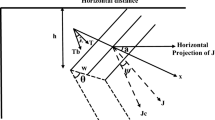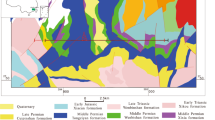Abstract
Acoustic reflection imaging in deep water wells is a new application scope for offshore hydrocarbon exploration. Two-dimensional (2D) geological structure images can be obtained away from a one-dimensional (1D) borehole using single-well acoustic reflection imaging. Based on the directivity of dipole source and four-component dipole data, one can achieve the azimuth detection and the three-dimensional (3D) structural information around the wellbore can be obtained. We first perform matrix rotation on the field four-component data. Then, a series of processing steps are applied to the rotated dipole data to obtain the reflector image. According to the above dipole shear-wave imaging principle, we used four-component cross-dipole logging data from a deviated well in the South China Sea to image geological structures within 50 m of a deviated well, which can delineate the structural configuration and determine its orientation. The configuration of near-borehole bedding boundaries and fault structures from shear-wave imaging results agrees with those from the Inline and Xline seismic profiles of the study area. In addition, the configuration and orientation of the fault structure images are consistent with regional stress maps and the results of the borehole stress anisotropy analysis. Furthermore, the dip azimuth of the bedding boundary images was determined using borehole wall resistivity data. Results of this study indicate that integrating borehole acoustic reflection with seismic imaging not only fi lls the gap between the two measurement scales but also accurately delineates geological structures in the borehole vicinity.
Similar content being viewed by others
References
Amer, A., Sajer, A., Al-Adwani, T., Salem, H., and Abu-Taleb, R., 2019, The application of downhole seismic imaging in identifying natural fracture systems: An integrated approach utilizing core and borehole image data: SPE Middle East Oil and Gas Show and Conference, SPE-194903-MS, Manama, Bahrain.
Aki, K., and Richards, P. G., 1980, Quantitative seismology: Theory and methods: W. H. Freeman and Company, CA, America.
Ben-Menahem, A., and Kostek, S., 1991, The equivalent force system of a monopole source in a fluid-filled open borehole: Geophysics, 56(9, 1477–1481.
Bonnet, E., Bour, O., Odling, N. E., Davy, P., Main I., Cowie, P., and Berkowitz B., 2001, Scaling of fracture systems in geological media: Reviews of Geophysics, 39(3, 347–383.
Bradley, T., Patterson, D., and Koscheev, G., 2017, Modern advances in acoustic reflection imaging: 58th SPWLA Annual Logging Symposium, Oklahoma, USA.
Chabot, L., Henley, D. C., Brown, R. J., and Bancroft, J. C., 2001, Single-well imaging using the full waveform of an acoustic sonic: 71th SEG Annual International Meeting, Expanded Abstracts, 420–423.
Chen, M., Yang, H., Wang, X., Sun, B., and Wang, S., 2017, Application of acoustic reflection imaging technology to complicated block reservoirs: Fault-Block Oil and Gas Field (in Chinese), 3(24, 351–354.
De, G. S., and Schmitt, D. P., 2005, Issues with shear-wave azimuthal anisotropy in highly deviated wells: Offshore Technology Conference, OTC 17647, Houston, Texas.
Esmersoy, C., Chang, C., Kane, M., Coates, R., Tichelar, B., and Quint, E., 1998, Acoustic imaging of reservoir structure from a horizontal well: The Leading Edge, 17(7, 940–946.
Hao, Z., Sun, X., Liu, X, Chen, H., and Zhang, G., 2014, The application research of dipole acoustic reflection imaging technology: Progress in Geophysics, 29(5, 2172–2177.
Heidbach, O., Rajabi, M., and Cui, X., 2018, The World Stress Map database release 2016: Crustal stress pattern across scales: Tectonophysics, 744, 484–498.
Hirabayashi, N., Leaney, W. S., and Haldorsen, J. B. U., 2008, Wavefi eld separation for borehole acoustic reflection surveys using parametric inversion: 78th SEG Annual International Meeting, Expanded Abstracts, 344–348.
Hornby, B. E., 1989, Imaging of near-borehole structure using full-waveform sonic data: Geophysics, 54(6, 747–757.
Hornby, B., Peterman, P., Hager, C., Draucker, A., and Bolshakov, A., 2018, Reflection sonic imaging of complex near-borehole structure in slow formations: 88th SEG Annual International Meeting, Expanded Abstracts, 684–688.
Hu, X., Zang, A., Heidbach, O., Cui, X., Xie, F., and Chen, J., 2017, Crustal stress pattern in China and its adjacent areas: Journal of Asian Earth Sciences, 149, 20–28.
Jia, C., Jiang, F., and Pang, X., 2016, Research status and development directions of hydrocarbon resources in China: Petroleum Science Bulletin (in Chinese), 1(1, 2–23.
Jiang, H., Pang, X., Shi, H., Liu, L., Bai, J., and Zou, S., 2015, Effects of fault activities on hydrocarbon migration and accumulation in the Zhu I Depression, Pearl River Mouth Basin, South China Sea: Australian Journal of Earth Sciences, 62(6, 775–788.
Kimball, C. V., and Marzetta, T. L., 1984, Semblance processing of borehole acoustic array data: Geophysics, 49(3, 274–281.
Lee, S. Q., Tang, X. M., and Su, Y. D., 2019, Shear wave imaging to determine near-borehole faults for ocean drilling exploration: Geophysical Journal International, 217(1, 288–293.
Okubo, P. G., and Aki, K., 1987, Fractal geometry in the San Andreas Fault System: Journal of Geophysical Research: Solid Earth, 92(B1), 345–355.
Rai, C. S., and Hanson, K. E., 1988, Shear-wave velocity anisotropy in sedimentary rocks: A laboratory study: Geophysics, 53(6, 800–806.
Tang, X. M., 2004, Imaging near-borehole structure using directional acoustic-wave measurement: Geophysics, 69(6, 1378–1386.
Tang, X. M., Cao, J., and Wei, Z., 2014, Shear-wave radiation, reception, and reciprocity of a borehole dipole source: With application to modeling of shear-wave reflection survey: Geophysics, 79(2), T43T50.
Tang, X. M., and Cheng, C. H., 2004, Quantitative borehole acoustic methods: Elsevier Science Publishing Inc, America.
Tang, X. M., and Patterson, D., 2005, Characterizing seismic anisotropy using cross-dipole measurement in deviated wells: 75th SEG Annual International Meeting, Expanded Abstracts, 372–375.
Tang, X. M., and Patterson, D. J., 2009, Single-well S-wave imaging using multicomponent dipole acoustic-log data: Geophysics, 74(6), WCA211-WCA223.
Tang, X. M., Zheng, Y., and Patterson, D., 2007, Processing array acoustic-logging data to image near-borehole geologic structures: Geophysics, 72(2), E87–E97.
Thomsen, L., 1986, Weak elastic anisotropy: Geophysics, 51(10, 1954–1966.
Zhang, G., Mi, L., Wu, S., Tao, W., He, S., and Lu, J., 2007, Deepwater area: The new prospecting targets of northern continental margin of South China Sea: Acta Petrolei Sinica (in Chinese), 2(28, 15–21.
Zhang, Y., Qi, J., and Wu, J., 2019, Cenozoic faults systems and its geodynamics of the continental margin basins in the Northern of South China Sea: Journal of China University of Geosciences (in Chinese), 2(44, 603–625.
Zhou, Z., Mei, L., Liu, J., Zheng, J., Chen, L., and Hao, S., 2018, Continentward-dipping detachment fault system and asymmetric rift structure of the Baiyun Sag, northern South China Sea: Tectonophysics, 726(15, 121–136.
Zheng, Y. B., and Tang, X. M., 2005, Imaging near-borehole structure using acoustic logging data with pre-stack F-K migration: 75th SEG Annual International Meeting, Expanded Abstracts, 360–363.
Author information
Authors and Affiliations
Corresponding author
Additional information
This work was supported by the National Natural Science Foundation of China (Nos. 41804124, 41774138, 41804121, 41604109), China Academy of Sciences Strategic Leading Science and Technology Project (Grant Nos. XDA14020304, XDA14020302), Shandong Provincial Natural Science Foundation, China (No. ZR2019BD039), Shandong Province Postdoctoral Innovation Project (No. 201901011) and China Postdoctoral Science Foundation (Grant Nos. 2019T120615, 2018M632745).
Lee Sheng-Qing received his Ph.D. degree from China Petroleum University (East China) in 2017. He is currently a postdoctoral fellow at China Petroleum University (East China), and he is mainly engaged in the study of borehole acoustic theory, methodology and field data interpretation, and gas hydrate logging.
Corresponding author: Tang Xiao-Ming is a professor with the China Petroleum University (East China). He received a B.S. degree from Beijing University in 1982 and a Sc.D. degree from MIT in 1990. His major research interests are in geophysical (sonic) well logging, seismic wave propagation, and rock physics.
Rights and permissions
About this article
Cite this article
Lee, SQ., Chen, M., Gu, XH. et al. Application of four-component dipole shear reflection imaging to interpret the geological structure around a deviated well. Appl. Geophys. 16, 291–301 (2019). https://doi.org/10.1007/s11770-019-0778-x
Received:
Revised:
Published:
Issue Date:
DOI: https://doi.org/10.1007/s11770-019-0778-x




